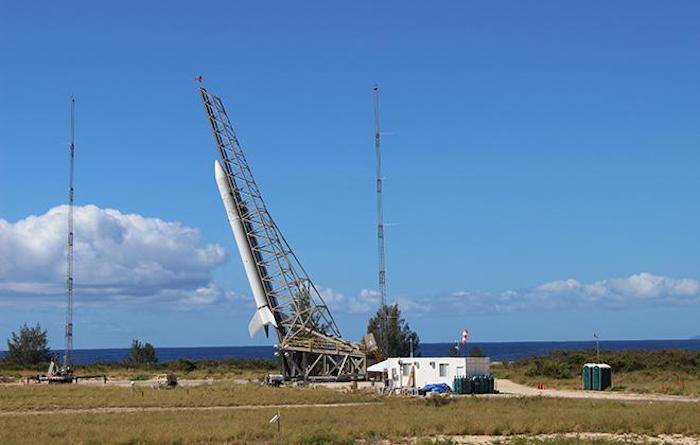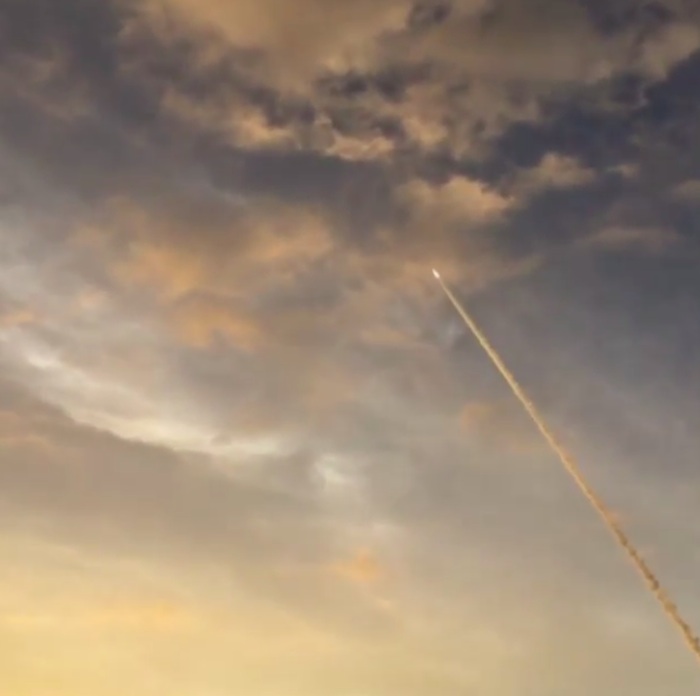.

The liftoff of the Super Strypi rocket from the Pacific Missile Range Facility on Kauai represents Hawaii's first satellite launch.
.
A 67-foot military-funded rocket that blasted off a rail launcher at the Pacific Missile Range Facility on Kauai at 5:45 p.m. today in Hawaii’s first satellite launch failed shortly after takeoff.
The Super Strypi rocket, called mission ORS-4, was shown spiraling upward from a camera mounted on the vehicle in a live feed, but an animation accompanying the launch soon showed the rocket tumbling before the screen went black just two minutes later.
Spaceflight Now, which broadcast the launch live, reported that the Air Force confirmed the failure, with the service saying in a statement:
“The ORS-4 mission on an experimental Super Strypi launch vehicle failed in mid-flight shortly after liftoff at 5:45 p.m. Hawaii Standard Time (7:45 p.m. PST; 10:45 p.m. EST) today from the Pacific Missile Range Facility off Barking Sands, Kauai, Hawaii. Additional information will be released as it becomes available.”
The Air Force’s Operationally Responsive Space office spent more than $45 million on the development of the Super Strypi mission, Spaceflight Now said. The University of Hawaii, a partner in the launch, said it was checking into the rocket’s failure.
Super Strypi, intended as an economical method of delivering payloads of 300 kilograms, or 661 pounds, to low-Earth orbit, was developed in coordination with Sandia National Laboratories, UH’s Space Flight Laboratory, the Pacific Missile Range Facility and Aerojet Rocketdyne.
The three-stage flight carried UH’s HiakaSat satellite and 12 much smaller satellites called “CubeSats.” The maiden flight represented the largest propulsion system ever launched from a rail system, said Aerojet Rocketdyne, which supplied the three-stage solid-rocket motors.
UH was responsible for payload development and project management of the rail launcher and launch pad. UH’s faculty and students built the primary HiakaSat payload. “Hiaka” means “to recite legends or fabulous stories” in Hawaiian.
“The Super Strypi design is projected to reset the bar for low cost small launch below $20 million with a production goal of $15 million,” Lt. Gen. Samuel Greaves, commander of the Space and Missile Systems Center and Air Force Program Executive Officer for Space, said in a release. “The University of Hawaii has been critical to bringing this capability to fruition.”
The Pentagon has historically relied on medium and heavy launch vehicles to place national security space payloads into orbit, which typically takes two to three years from initial order to launch date, according to the U.S. Government Accountability Office.
“Without a complex and costly guidance system, the (Super Strypi) launch aims to demonstrate a concept that cuts preparation and processing time from months to weeks, thereby slashing the cost of launching small satellites into orbit,” Aerojet Rocketdyne said on its website.
The Pentagon is seeking methods of rapidly replenishing satellites as countries such as China develop anti-satellite weapons systems.
The flight originally was scheduled for October 2013, but was pushed back multiple times due to technology and timing issues. More recently, the satellite launch was set for Thursday, then Friday and Monday before today’s launch.
Super Strypi is a bigger version of a Sandia-developed Strypi suborbital “sounding” rocket design from 1962 used for research and launched from Kauai at least as far back as 1995.
The 121-pound HiakaSat was to demonstrate UH-developed long-wave infrared hyper-spectral imaging. It was outfitted with two color cameras to provide wide- and narrow-view images of Earth. Images could be transmitted back that provide data on global warming, ocean temperatures, coral bleaching, volcanoes and other environmental issues, the university has said.
The Hawaii Space Flight Laboratory was established in 2007 within the School of Ocean and Earth Science and Technology and the College of Engineering.
Quelle: staradvertiser
.
Rocket launch from Hawaiʻi carrying UH payload experiences anomaly

The U.S. Navy along with the U.S. Air Force’s Operationally Responsive Space Office, in partnership with Sandia National Laboratories, the University of Hawaiʻi’s Hawaiʻi Space Flight Laboratory, the Pacific Missile Range Facility and Aerojet Rocketdyne Corp. launched the first rocket from Hawaiʻi.
After take-off, the experimental launch vehicle experienced an anomaly. ORS is currently assessing the cause.
The rocket was launched from the U.S. Navy’s Pacific Missile Range Facility at Barking Sands, Kauaʻi, through a mission known as ORS-4. The mission was sponsored by the Space and Missile Systems Center’s Operationally Responsive Space Office and was the first launch of the Super Strypi launch system. The rocket was carrying UH’s hyperspectral imager as the primary payload, along with 12 cubesats in an integrated payload stack.
Despite the vehicle issue, the project is still a tremendous success for University of Hawaiʻi. About 150 students worked on the payload, a hyperspectral imager called HiakaSat. All milestones for the payload were met and the students received real-world aerospace experience in building a sophisticated satellite.
Because of this project, there is now a rocket launch pad and rail launcher in place at Pacific Missle Range Facility and those assets performed well today. There are also tracking stations in place at Kauaʻi Community College and Honolulu Community College that are fielding requests for services from commercial agencies. UH students at multiple campuses, including the community colleges, are currently working on payloads for future space launches.
Quelle: University of Hawaiʻi
4566 Views
